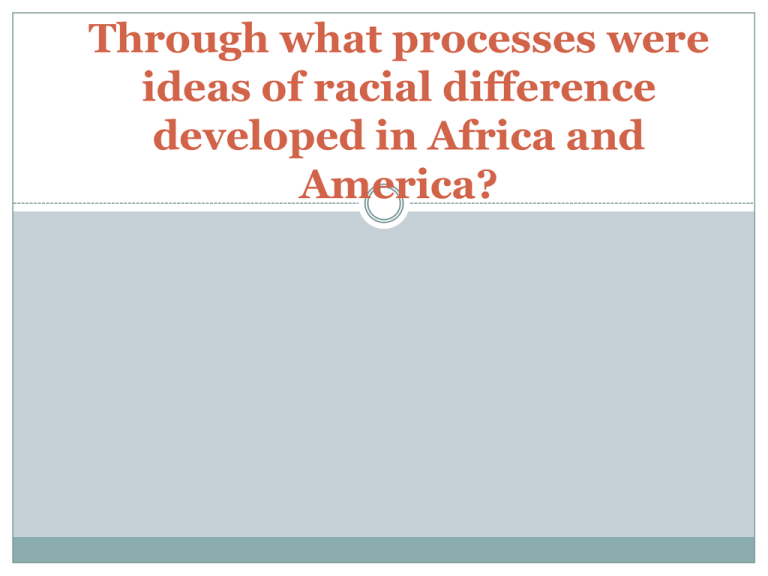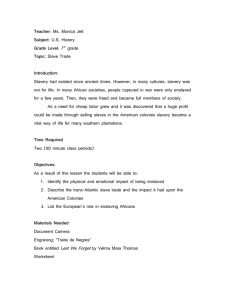Eleanor Lewis
advertisement

Through what processes were ideas of racial difference developed in Africa and America? Introduction – What is race? Race as a cultural construct. “ Race as a mechanism of social stratification and as a form of human identity is a recent concept in human history” First used in the 16th century in the English language to describe humans as part of England’s contact with wider world. Race only came to be used in its modern sense in the American colonies in 18th century, as “a form of social identification and stratification grounded in differences in physical appearance but whose real meaning lay more in social and political realities.” Development of racial difference in America and Africa 1) The Transatlantic Slave Trade - undeniably racist institution. “The trade partly Africanized portions of the New World; it permitted the rise of tropical plantation economies and brought about a transatlantic variety of hereditary serfdoms in which bonds-men came to be distinguished by the color of their skin.” Dunnigan and Gann, The United States and Africa: A History Slavery A) Ideas of racial difference led to slavery. Enlightenment ideas of human progress and civilisation, overseas imperialism and AngloSaxonism developed attitude of racial superiority amongst English B) Slavery and racial difference as a solution to economic, social and political need Slavery Slavery “was the practical facet of a general debasement without which slavery could have no rationality. (Prejudice too, was a form of debasement, a slavery of the mind.) Urgent need for labour moulded debasement and put it into institutional framework. That economic practicalities shaped the external form of debasement should not tempt one to forget, however, that slavery was at bottom a social arrangement, a way of society's ordering its members in its own mind.” Winthrop D. Jourdan, in Major Problems in African and American History Slavery “It was slavery that made Virginians dare to speak a political language that magnified the rights of freemen….The very institution that was to divide North and South after the Revolution may have made possible their union in a republican government.” Edmund S. Morgan, Major Problems in African- American History Development of racial difference in America and Africa 2) Debates over African Identity and the establishment of colonies in Liberia and Sierra Leone in the 18th and 19th centuries. African descended authors who alluded to heritage of slave trade, creating unity of those affected, and a new identity based on shared racial origins. Differed themselves from Africans on the continent. Wanted to christianize and “civilise”. Emigrationist thought led to development of AfricanAmerican colonies of Sierra Leone and Liberia. New diasporic identity – not African and not wholly American. Discourse disintegrates as realisations that the ACS (American Colonization Society) served slaveholders interests only. “Colored” replaced “African” Olaudah Equiano – convinced abolitionist. His autobiography, The Interesting Narrative of the Life of Olaudah Equiano, depicts the horrors of slavery and influenced the enactment of the Slave Trade Act of 1807 HOWEVER…. Although ideas of racial difference did develop via these processes, other identities were forming at the same time that are just as important to understand the history of the relations between Africa and America. Gilroy – “Many black intellectuals born out of the slave trade travelled and worked in a transnational frame that precludes anything but a superficial association with their country of origin” Conclusion By beginning of 20th century, racial difference solidly established in North America and unsatisfying situation in regards to the conditions of African Americans. The further development of Pan-Africanist thought in the 19th and 20th centuries, WW2 and eventually the Civil Rights movement would provide platforms to explore and find flaws in these ideas of racial difference and as Gilroy argues, “articulate a desire to escape the restrictive bonds of ethnicity, national identification and sometimes even “race” itself.” Bibliography Duignan, Peter and Lewis Gann. The United States and Africa: A History, 1994 Gilroy, Paul, The Black Atlantic: Modernity and Double Consciousness, 1993 Holt, Thomas and Barkley Brown, Elsa, ed., Major Problems in African-American History, 2000 Jalloh, Alusine and Toyin Falola, eds., The United States and West Africa: Interactions and Relations, 2008 Sidbury, James, Becoming African in America: Race and Nation in the Early Black Atlantic, 2007 Smedley, Audrey, "Race" and the Construction of Human Identity,, American Anthropologist , New Series, Vol. 100, No. 3, 1998



